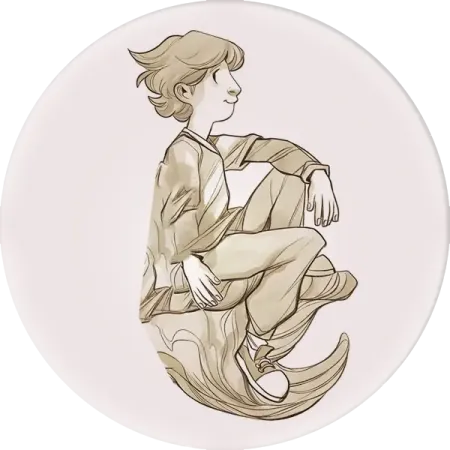In the belly
of the whale
A refuge among bones. And outside, a storm rages.
Is it a ship, or a monster?
The rule is simple:
enter, be welcome while
the storm lasts, then be gone.
Anne shook her head, as if to make sure she wasn’t dreaming. They had ended up inside something that, at first glance, resembled the interior of a ship — or at least that’s the impression given by the huge ribs rising straight from the ground, covered in some kind of coarse fabric on the outside.
How big the whole structure was couldn’t be said, as its outlines vanished far into the darkness. But it was clear this thing was enormous.
“I didn’t think we’d get out of that alive,” Anne muttered, barely able to speak. “I feel like I’ve been trampled... Excuse me, where are we?” she asked the guard, who had hung his cloak by the door and was now silently observing them.
It turned out to be an old, plump badger. He wore something like a tunic or a rough robe, made from a single large piece of cloth thrown over his shoulders and tied at the waist with a rope belt. His enormous gray whiskers twitched slightly, as if he were constantly chewing something. That, in fact, was the only movement visible in his face. Everything else was completely still. Anne, trying in vain to read something in his impenetrable expression, was starting to feel a little awkward.
“I hope we’re not bothering you,” she added politely. “It seems roomy enough here for three more... three more children.”
“You’re lucky there’s a storm outside,” the badger grumbled. “Otherwise, you wouldn’t have gotten in so easily. We don’t have room for new residents. Everything is claimed, down to the last spot — and there are things lurking out there... But never mind. You can stay until the storm calms down. After that, you’ll have to leave. That’s how it works here, in the Belly of the Whale.”
“The Belly of the Whale?” Anne was so surprised she didn’t even react to his rude tone. “Wait — is this really a whale? A real one? Huge?”
“Well, that’s what we call it,” the badger replied, a little softer now. “No one knows what kind of monster left its bones here — or where it came from. But it’s long dead now. All that’s left is the giant skeleton and the fossilized hide. And as you can see, it makes a fine home. We don’t complain. Places like this are rare in the forest. That’s why every lazy drifter is dying to find a cozy corner here. But they’ve got another thing coming!”
Reflections on the scene
⸻ ❦ ⸻
– ❦ –
No monsters, no magic, no chase—just shelter. That’s what makes this scene feel so strangely powerful. After the brutal loss of Fido, Anne and her companions are finally allowed to collapse, and the Forest—this time—doesn’t spit them back out. It swallows them whole.
The Belly of the Whale isn’t just a name. It’s a clear nod to Jonah, Pinocchio, even Star Wars. In all of those, the belly is where heroes go not to act, but to be changed. This is a pause—not in the plot, but in the characters. Anne’s body aches. Peter’s fear spills over. Pouchy massages limbs and spirits. And then: the rules of the shelter.
Because this place has rules. Ration water. Share food. Don’t outstay your welcome. Help when you can. What could have been a cozy hideout instead becomes a reminder: survival here is a shared effort. There’s no luxury in safety—only responsibility.
Mr. Gyurow and Kuma Alisa aren’t magical guides. They’re caretakers with worn routines and matter-of-fact kindness. They open their doors only when storms rage. And yet—how rare and radical that is: a sanctuary in the midst of ruin.
Here, the forest doesn’t test you with riddles or chase scenes. It tests whether you can pause, be grateful, follow someone else’s rhythm for a moment. Whether you can rest—without forgetting the world’s still broken outside.






